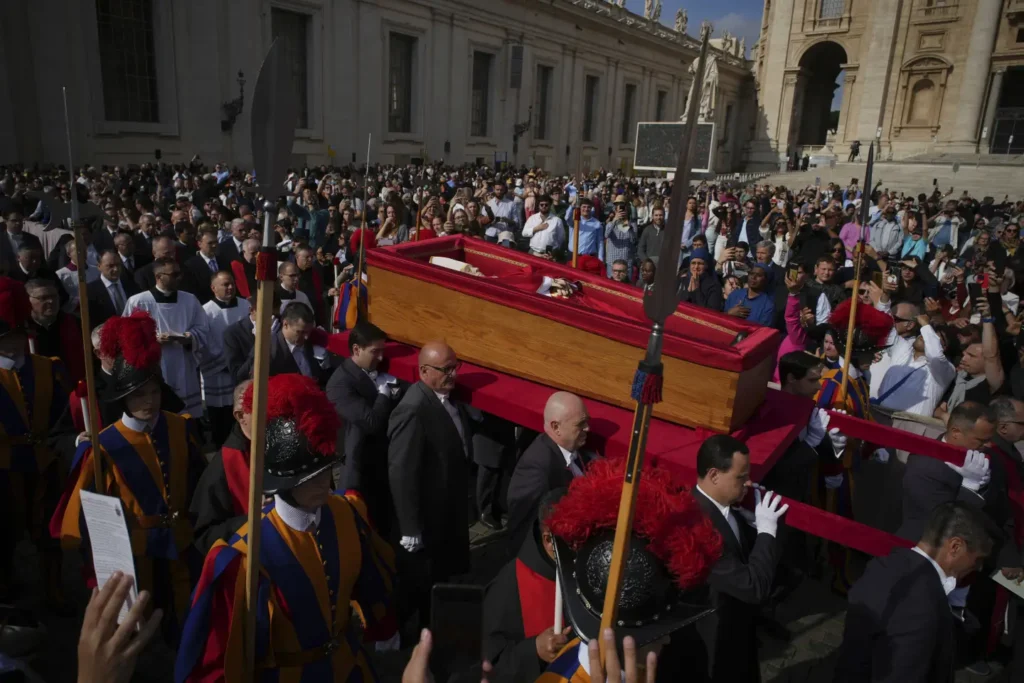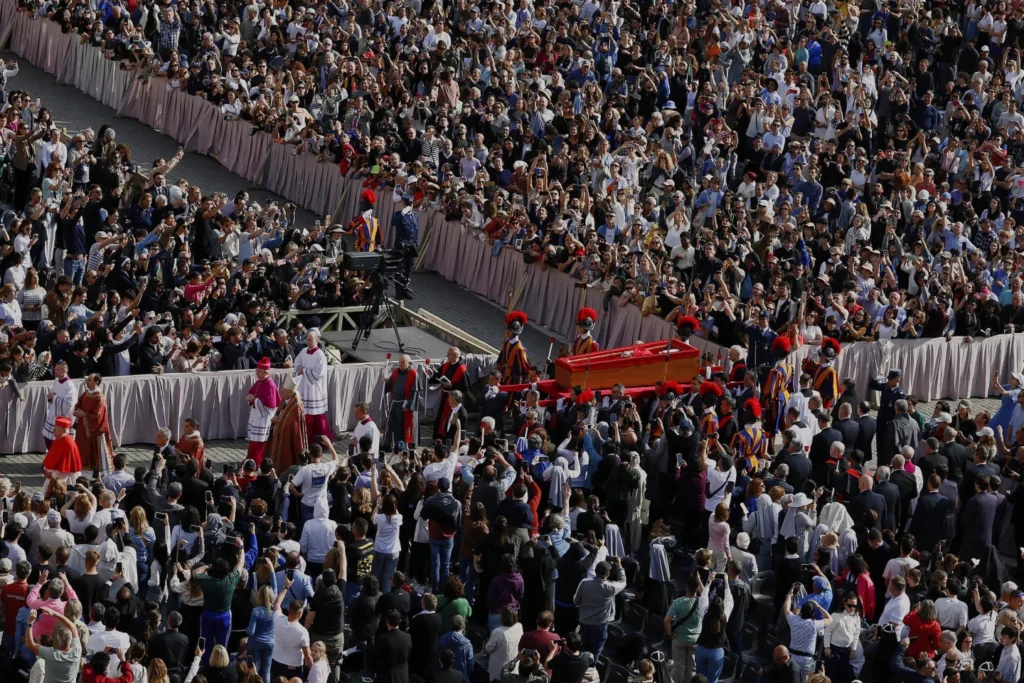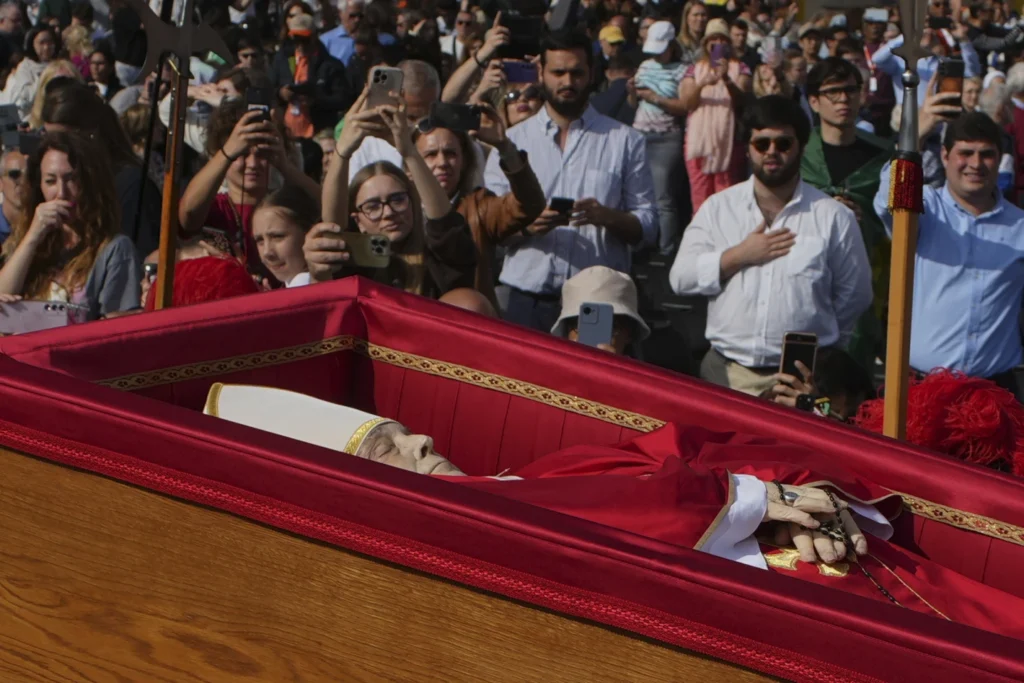VATICAN CITY — Tens of thousands of Catholics are descending on St. Peter’s Basilica to pay tribute to Pope Francis, as the Vatican opened three days of public viewing on Wednesday, following the pontiff’s death earlier this week at the age of 88.

The late pope’s wooden casket was placed at the main altar of the 16th-century basilica, where a stream of mourners filed past in reverent silence, many snapping photographs or clasping rosaries in prayer. Francis, dressed in traditional red papal vestments and a bishop’s miter, lay in repose with a rosary entwined in his folded hands.
Swiss Guards stood solemnly at attention, flanking the casket as the faithful quietly made their way down the aisle. In the first eight and a half hours of the viewing, the Vatican reported that 19,430 people had paid their respects — a turnout so significant that Vatican officials are considering extending viewing hours.
“It gave me chills,” said Ivenes Bianco, who traveled from Brindisi in southern Italy for medical treatment but made sure to come pay homage to the late pontiff. “He was important to me because he brought people together. He encouraged coexistence.”
Pope Francis, who led the Catholic Church for more than a decade, had requested a modest farewell. In line with his wishes, the casket was not elevated on a bier, as was tradition for previous popes, but placed on a sloped platform facing the pews — a gesture reflecting his belief that the pope should be seen primarily as a pastor, not a global political figure.
His body first lay in state at the Vatican guesthouse where he lived throughout his pontificate, allowing members of the papal household and Vatican staff a private moment of farewell. Public viewing commenced after his body was transferred in a solemn morning procession through St. Peter’s Square.

The tolling of bells marked the arrival of the casket, as Cardinal Kevin Farrell — currently overseeing Vatican operations during the sede vacante — led the procession with clouds of incense and the singing of the Litany of the Saints. Cardinals followed in pairs, bowing before the casket and making the sign of the cross, with bishops, priests, nuns, and ushers proceeding behind.
As the basilica opened to the public, the atmosphere grew reverent and subdued. The squeaking of shoes on marble, whispered prayers, and the sound of children’s voices echoed under the soaring dome.
“It felt like losing a family member,” said Rosa Morghen of Naples. “He was like a father, a grandfather — someone close to us all.”
Public viewing will continue through Friday at 7 p.m. local time. Francis’ casket will then be sealed in preparation for his funeral, which is set to take place Saturday at 10 a.m. in St. Peter’s Square.
World leaders are expected to attend the funeral, including U.S. President Donald Trump and Ukrainian President Volodymyr Zelenskyy, underscoring Francis’ influence on global affairs and his enduring calls for peace, interfaith dialogue, and care for the poor.
The funeral rites, designed by Francis before his death, will be more understated than those of his predecessors. Still, the event will be steeped in tradition and is expected to draw a massive international audience both in person and via global broadcast.

Francis died Monday following complications related to pneumonia and prolonged hospitalization. His 12-year papacy was marked by an emphasis on mercy, social justice, and outreach to the marginalized — a tenure both praised for its compassion and criticized by some conservative factions for its progressive tone.
Following the funeral, the Catholic Church enters a sacred period of transition as the College of Cardinals prepares to elect a new pope in a secret conclave inside the Sistine Chapel. Vatican officials confirmed that 133 cardinals under the age of 80 are eligible to vote, though two have stepped back due to health reasons. The conclave is not expected to begin before May 5.
“There’s uncertainty, of course,” said South Korean Cardinal Lazarus You Heung-sik, who leads the Vatican’s office for clergy. “But we’ll see what the Holy Spirit says.” Asked whether the next pontiff could come from Asia, he replied: “For the Lord, there’s no East or West.”
Cardinal John Ribat of Papua New Guinea, the nation’s first and only cardinal, is en route to Rome to take part in the papal election. “To represent the South Pacific in the conclave is a great responsibility,” he told Australia’s ABC network. “We hope for a pope who will speak truth and unite the Church.”
Italian police have intensified security measures in and around Vatican City, with increased foot patrols and officers on horseback as the crowd of mourners and pilgrims continues to grow. Many are also in Rome for the Holy Year celebrations, which Pope Francis inaugurated in December.
“The death of a pope is not a small thing,” said Julio Henrique, a pilgrim from Brazil. “We’ve lost our leader. But now, we wait for a new one. That’s the beauty of our Church — it goes on. Hope remains.”
As Saturday’s funeral approaches, the Catholic faithful are mourning not just the loss of a pope, but a man who many saw as a shepherd to the modern world — one who challenged conventions while upholding faith.



